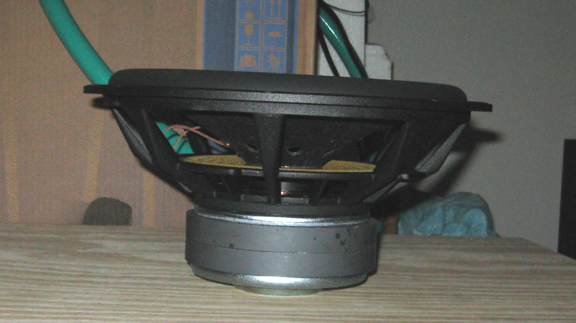
It's my opinion that closed box actively EQ'd woofers are the way to go. They're slightly less efficient than a ported box and substantially more efficient than an open-baffle approach. The ported box will need to be a bit larger physically than an optimal closed box. Also a ported box has mechanical woofer cone damping that is inconsistent over frequency. It's weak on either side of the tuned frequency. Trying to force an increase in low frequency response with active EQ can be dangerous. The woofer cone is more likely to "bottom out" due to the lack of damping by the trapped air inside the box acting as a spring.
The open-baffle approach is likely to be physically large since you need at least twice the cone surface area, and expensive when you've got to drop about a grand on four 10 or 12 inch drivers. The one advantage a ported box has is the additional 1/2 to 3/4 of an octave of bass frequency extension with no additional electronics needed to create it, so it's perhaps the cheapest way to make a decent enough speaker in a a production environment. Getting a one-off calibrated right is challenging unless you're very experienced.
In my room (probably a little smaller than is typical in the audiophile crowd), two of these closed box woofers described below are plenty good enough for my tastes. I arrange them such that one box is behind one of the open-baffle satalite speakers at the front wall, and the other is behind the other satalite speaker, and turned 90 degrees so it's maximum acoustic output is radiating to the right, rather than somewhat straight toward my main listening position in the room. By doing it that way, you get a more immersive feel because of the way the various wavelengths interact with the room boundaries (see papers written by David Griesinger, previously of Lexicon and arguably the main pioneer of digital reverb).
Below is the latest (2005ish) best Peerless XXLS 12 inch woofer that I used (the newer version of what Linkwitz had been using in his Orion speaker system).

The vented and raised spider allows for substantial cone travel at low distortions. Notice the cone venting in the above picture, for air under the "dustcap".
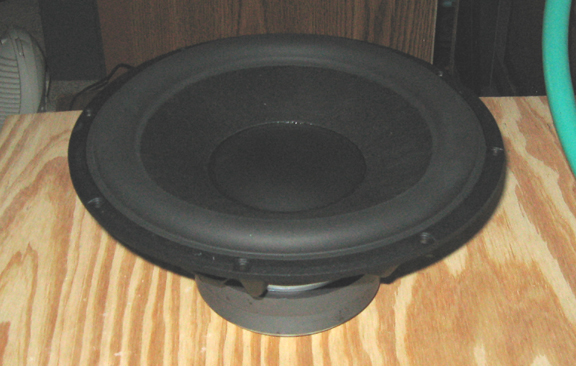
At almost $200 per, this is a pretty good value per dollar.
Below is the front and back preperation. Three quarter inch MDF with oak bracing is my preferred method. More mass in the cabinet means less lost energy at very low frequencies, when the cabinet will try to shake. I used some 1/4 inch MDF for the banana jack connectors on the back. Glued and screwed, for max mechanical rigidity and air seal.

Make sure cabinet pieces are all on a very flat surface when gluing sections together. I used finishing nalils to insure that things didn't slip out of alignment as I tightened the clamps. Later I center punched those nails deeper in, so I could router certain outer corners for better asthetic appeal, without hitting nails with my router bit. After routering, I filled in any nail related holes with filler before painting..
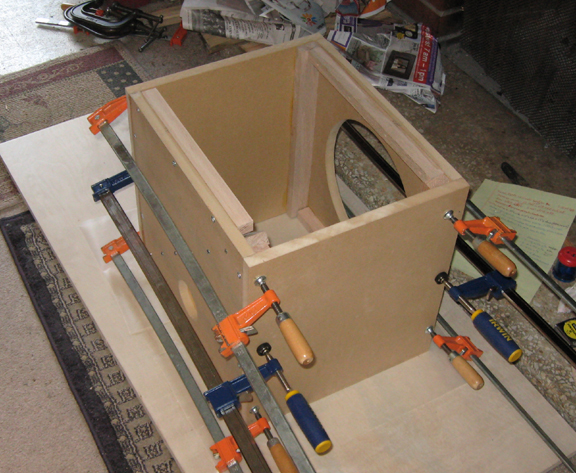
Oak braces in ALL corners.
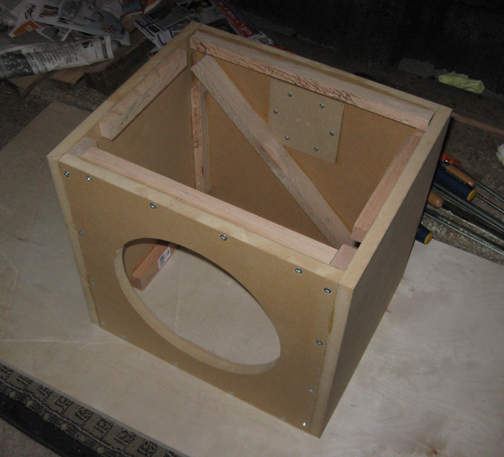
Another angle.
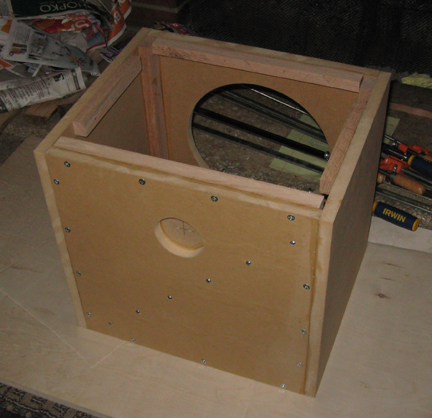
Anticipation...
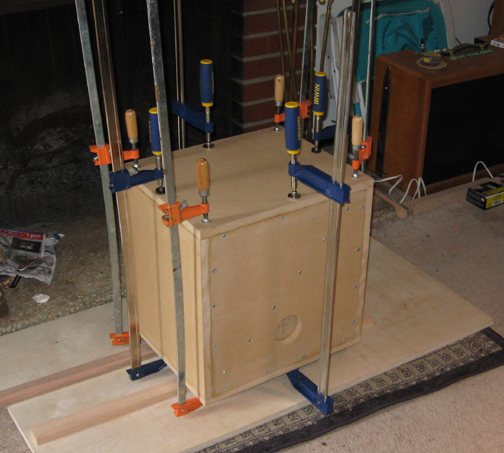
There's the crossbrace pieces, in the middle of the four sides (below). These are glued and clamped where they cross in the middle. When positioning crossbraces, make sure there's enough room for the driver magnet.
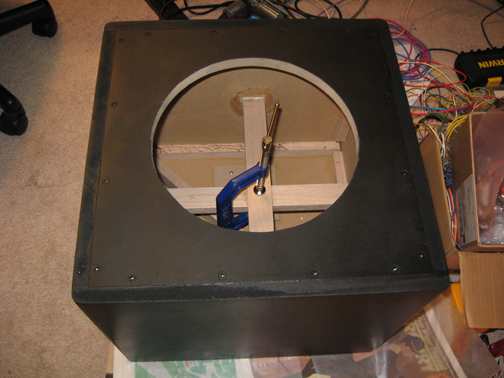
I use 16 AWG AC line cord from Ace Hardware store to wire the driver up to the banana jacks on the back (the same wire I use to go from the speakers to the power amp). I solder the wires at both ends, not just at the driver. Phase matters (plus on the driver goes to the red banana jack). It's arguable that a woofer box only going up to 100HZ needs no internal acoustic absorbtion material since the smallest wavelength is about 10 feet. If you do put such material in a cabinet (a must for midrange and high frequencies), stuffing a bunch of fiberglass insulation in helps but a more effective way is to glue thick (1/4 - 1/2 inch) felt, or equivelent, to the inside surfaces of the cabinet with a glue that never becomes brittle (I use Liquid Nails or Silicaone rubber glue), and double up the thickness in any corners. Then soft foam rubber is one of the better acoustic absorbers.
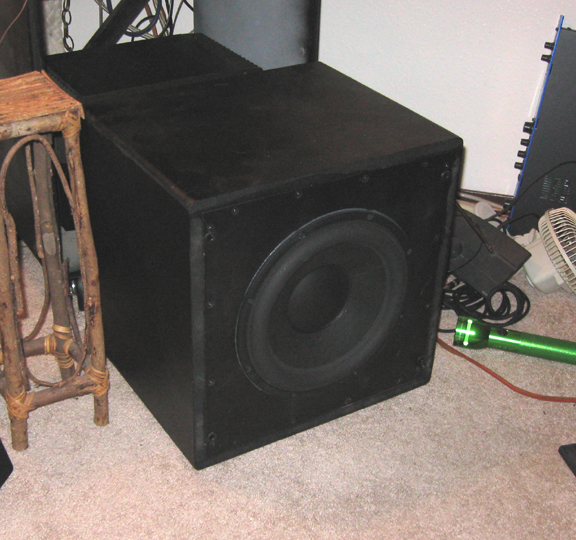
Without grill frame.
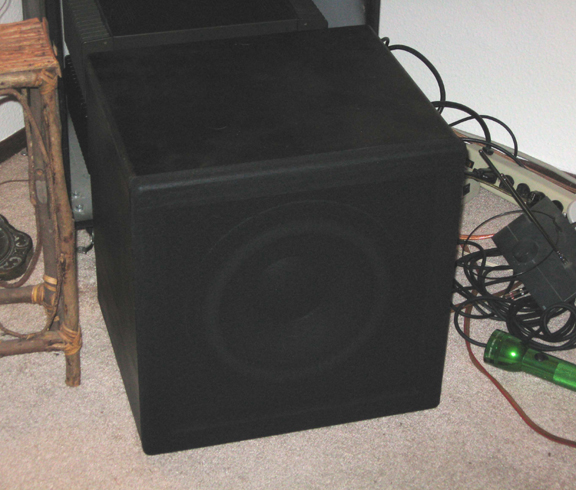
With grill frame.
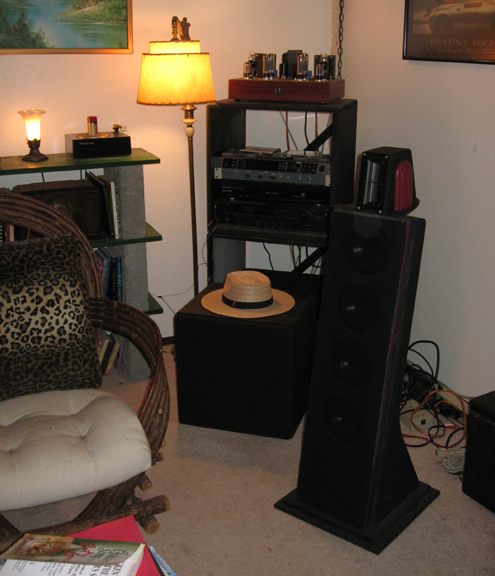
Home is where you hang your hat.
Right behind the woofer shown above is a few Hafler DH-220's, delivering 120 watts rms to each of the two woofers. They get a mono signal from the 4 pole active lo-pass /active EQ circuit, which makes it measure relatively flat to 20 HZ at the listener postion, in my room. Very low bass notes are of coarse fun, but drums have sub-harmonics that go way down in frequency. With real world music, as opposed to test signals, every sound at any frequency is delivered in an "envelop". These envelops will usually have energy that goes all the way down to near DC. So having an acoustic frequency response that is somewhat flat down to 20 HZ will improve the overall sense of realism for every part of the music. Want more bass for a bigger room? Add two more of these boxes. It's that simple. You'll get more power out of the poweramp, and the EQ is already in place. Additional woofs must be wired in phase and in parallel with existing ones.
The grill cloth frame is also made of oak (routered front corners). For cloth, I used textured black shear nylon/spandex stuff from a fabric store. In decent lighting, you can just see the driver through the grill cloth. Looks very cool.
I'm very pleased with the results.
